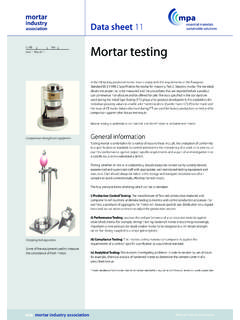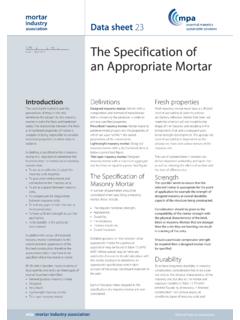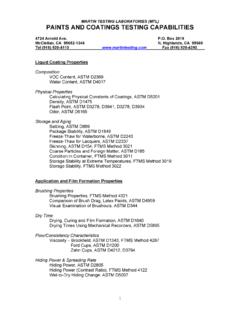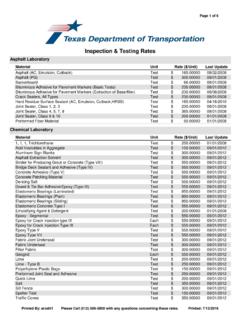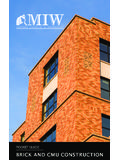Transcription of MIA A4 Data Sht 1 - Mortar
1 Data sheet 01. CI/SfB Yq4. Issue 8 May 2017. (SUPERSEDES Issue 7 March 2017) factory produced lime:sand Mortar for masonry General Composition and Information Manufacture Mortar Industry Association members below shows mix designations and the manufacture their lime:sand products from amount of cement to be added on site. carefully selected clean sand (now known as fine aggregate) conforming to BS EN 13139 When mixing, it is important that the with lime conforming to BS EN 459-1. designation of the Mortar is correct for the Correctly gauged Mortar mixes conform to type of work and that if coloured Mortar is BS EN 998-2, when tested by the methods being used, it is the agreed shade.
2 With given in BS EN 1015 and BS 4551. If required, coloured mortars , it is recommended that a pigments conforming to BS EN 12878 can be small trial panel be constructed to ensure accurately added at the factory to produce that the interaction of the texture and colour an extensive range of colours and shades. of the bricks on the Mortar will produce the The mortars are generally delivered in bulk, desired effect. factory produced lime:sand is a blend of with skips or bags also available. The table sand and lime to which cement is added on site, to produce masonry mortars that can have a range of desired Table 1: Mix designation and cement gauging strengths and performance characteristics pre-determined by the Mortar Mortar by factory Site mixing Mortar class Suitable specifier or user (For more information, designation volume produced Cement: that may be for use in see Data Sheet 18).
3 Cement:lime: by volume factory assumed environmental sand lime:sand produced condition lime:sand By volume i 1:1 4:3 1:12 1:3 M12 Severe (S). ii 1:1 2:4 - 41 2 1:9 1:41 2 M6 Severe (S). iii 1:1:5 - 6 1:6 1:6 M4 Moderate (M). iv 1:2:8 - 9 1:41 2 1:9 M2 Passive (P). When the sand portion is given as, for example, 5 to 6, the lower figure should be used with sands containing a higher proportion of fines, whilst the higher figure should be used with sands containing a lower proportion of fines. Cements in accordance with NA. (except masonry cements), or combinations in accordance with Mortar mixes conform to BS EN 998-2, when tested by the methods given in BS EN 1015 and BS.
4 4551. NB Mortar class/designation as defined in the National Annex to BS EN 998-2, clause NA-1. mia Mortar industry association Mineral Products Association Properties These mortars used in accordance with EN Coverage 1996-1-1 Eurocode 6 are suitable for all types 1 tonne of cement:lime:sand Mortar will lay approximately 1000 bricks or 600 blocks of nominal of masonry applications, particularly housing size 450 x 225 x 100mm. and other medium and low rise structures. Brickwork and blockwork constructed with these mortars will retain a degree of elasticity so that the inevitable movement of buildings during and after construction can be accommodated with minimal cracking, which is both unsightly and a cause of remedial costs.
5 Tipped, unless delivered in skips, onto a clean New work should be protected in Durability area with a sealed base, slab or similar accordance with good working practice at Masonry mortars made with cement and prepared area and sheeted when not in use. the end of the working day or when work is factory produced lime:sand help to produce Sheeting is most important when colour is a interrupted by adverse weather. Scaffold a durable weatherproof and frost resistant requirement, as rain and weathering may planks placed along the top of walls give at joint through which rain will not easily otherwise cause separation of some of the least some protection from saturation by rain.
6 Penetrate. Cracking is minimal, but any that fine material. Ideally, the tops of unfinished work should be does occur tends to be minor and self- properly covered; this is especially important healing due to the combined effects of with cavity walls and where perforated bricks moisture and carbon dioxide in the To obtain the final Mortar mix, considerable are used. Protection from drying sunshine atmosphere. The action of these will, by slow care should be taken on site to add the and wind should also be carried out to allow carbonation, tend to fill and seal minor cracks correct amount and type of cement.
7 Gauge the Mortar to cure appropriately. through autogenous healing (See MIA Data boxes or other accurate measuring vessels Sheet 18). should be used when proportioning is by volume. When using coloured mortars , it is Although cement:lime:sand mortars should strongly advised that the same brand, type be used within the 1-2 hours workable life, and source of cement is used throughout the most will remain relatively soft for a typical Working contract. working day, making cleaning up at the end characteristics of each shift reasonably easy. All mixers, spot boards and trowels, etc.
8 , should be cleaned at mortars made with cement and factory For the volume and type of cement for the the end of each shift or when changing the produced lime:sand have good plasticity and various designations of Mortar refer to BSEN colour of the Mortar . workability. They can help to completely fill 998-2 for full details and from where the the vertical as well as the horizontal joints in majority of Table 1 information originates. masonry, assisting with the attainment of good quality workmanship. The Mortar , Recommended Ensure that only clean water is used for whilst possessing a high degree of cohesiveness that helps to reduce wastage making mortars and adjust the quantity Mortar Mixes for due to dropping, spreads easily under the carefully to obtain the desired and appropriate consistency for the work.
9 Various Conditions trowel, thus increasing productivity and Reference should be made to British Standard reducing mason fatigue. BS EN 1996-1-1 having regard to the Stacked bricks, blocks and tiles should be requirements for strength durability and protected from the weather. They should not appearance. The mortars have high water retentivity be used when saturated with water or when enabling the Mortar to resist the suction of frozen as this can lead to disfiguration of the the bricks, blocks or tiles and remain workable while laying is carried out. This masonry and therefore the building and in winter, may lead to attack on the masonry by Maintenance helps to ensure good bond and reduces the frost.
10 In summer, protection from sunshine Generally, walls constructed with mortars need to re-temper. should be in place to prevent the bricks, containing lime minimises the maintenance blocks or tiles from being hot and causing requirements. See MIA data Sheet 18. It is recommended that deliveries of factory rapid moisture loss from the Mortar after produced lime:sand for Mortar should be laying. References BS EN 197-1 Cement composition, specification and conformity criteria for common cements BS EN 459-1 Building lime. Definitions, specifications and conformity criteria BS EN 998-2 Specification for Mortar for masonry - Part 2:Masonry Mortar BS EN 1015 Methods of test for Mortar for masonry BS EN 12878 Pigments for the colouring of building materials based on cement and/or lime.

